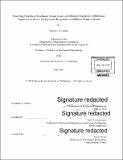Modeling nonlinear stochastic ocean loads as diffusive stochastic differential equations to derive the dynamic responses of offshore wind turbines
Author(s)
Larson, David F. H
DownloadFull printable version (4.399Mb)
Other Contributors
Massachusetts Institute of Technology. Department of Mechanical Engineering.
Advisor
Paul D. Sclavounos.
Terms of use
Metadata
Show full item recordAbstract
A procedure is developed for modeling stochastic ocean wave and wind loads as diffusive stochastic differential equations (SDE) in a state space form to derive the response statistics of offshore structures, specifically wind turbines. Often, severe wind and wave systems are highly nonlinear and thus treatment as linear systems is not applicable, leading to computationally expensive Monte Carlo simulations. Using Stratonovich-form diffusive stochastic differential equations, both linear and nonlinear components of the wind thrust can be modeled as 2 state SDE. These processes can be superposed with both the linear and nonlinear (inertial and viscous) wave forces, also modeled as a multi-dimensional state space SDE. Furthermore, upon implementing the ESPRIT algorithm to fit the autocorrelation function of any real sea state spectrum, a simple 2-state space model can be derived to completely describe the wave forces. The resulting compound state-space SDE model forms the input to a multi-dimension state-space Fokker-Planck equation, governing the dynamical response of the wind turbine structure. Its solution yields response, fatigue and failure statistics-information critical to the design of any offshore structure. The resulting Fokker-Planck equation can be solved using existing numerical schemes.
Description
Thesis: S.B., Massachusetts Institute of Technology, Department of Mechanical Engineering, 2016. Cataloged from PDF version of thesis. Includes bibliographical references (page 54).
Date issued
2016Department
Massachusetts Institute of Technology. Department of Mechanical EngineeringPublisher
Massachusetts Institute of Technology
Keywords
Mechanical Engineering.